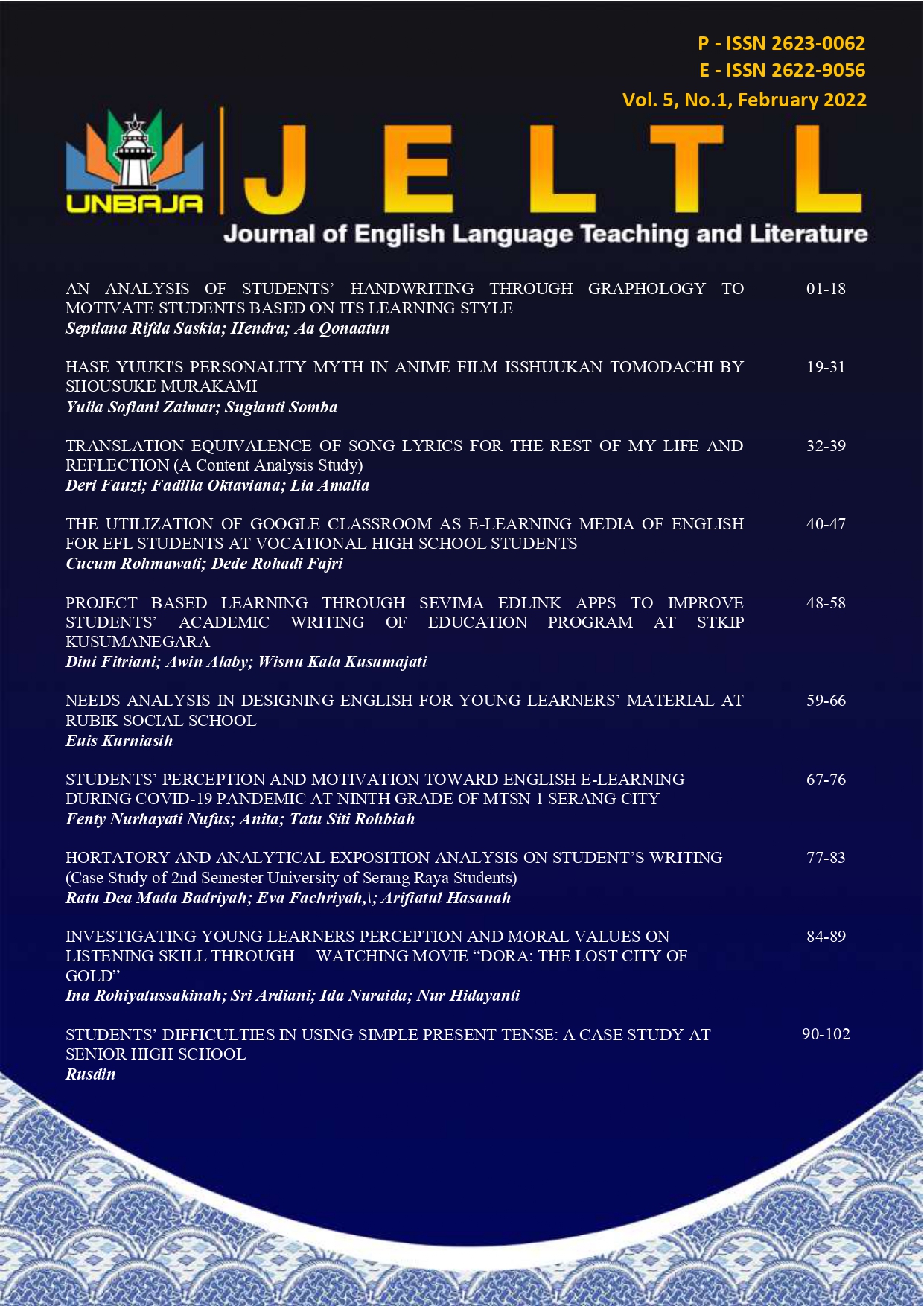HASE YUUKI'S PERSONALITY MYTH IN ANIME FILM ISSHUUKAN TOMODACHI BY SHOUSUKE MURAKAMI
DOI:
https://doi.org/10.47080/jeltl.v5i1.1860Keywords:
anime, film, tanda, semiotik, dan psikoanalisisAbstract
ABSTRACT
In this research, the researcher will examine Japanese animated films, Isshuukan Tomodachi. Isshuukan Tomodachi is a film that aired on February 18, 2017. The film was directed by Shousuke Murakami. Actualy, this anime film,taken for manga. The researcher is intrested in this film, because he sees many keys, how tobe a good friend. This research will be exposing the pischological of the main charater, Hase through signs. Those signs would find out the hidden meaning behind the text (myth). The researcher choses Isshuukan Tomodachi to be reseached, because it has excellent story quality and has elements of drama and romance combined nicely, because what is at the heart of the story is the complexity of the human heart itself in accepting the situation within itself, being honest with its own feelings, and the strength of friendship. As the result, many people are very difficult to make friends. The reason is not about arogancy. The results of this research, through the signifier and signified, show that Hase has an id that is not as big as the ego and superego. Hase can suppress the id so as not to get bigger and control himself Hase, which he shows by leaning on Kaori's father. This will be the foundation of analyzing.
Downloads
References
a. Text Book:
Alwisol.(2008). Psikologi Kepribadian. Edisi Revisi. Malang : UMM Press.
Barthes, R. (1967). Elements of Semiology. London : Jonathan Cape.
Barthes, Roland. (1977). Image, Music, & Text. Hill & Wang
Barthes Roland. (2004). Mitologi. Terj. Nurhadi & Sihabul Millah), Kreasi Wacana, Yogyakarta
Creswell, John W. (2002). Desain Penelitian. Jakarta: KIK Press.
Damajanti, Irma. (2006). Psikologi seni. Bandung: PT. Kiblat Buku Utama.
Endraswara, Suwardi. (2008). Metodologi Penelitian Sastra. Yogyakarta: Media. Pressindo
Feist, J. & Gregory J. Feist. (2010). Teori Kepribadian (Edisi ketujuh). Jakarta: Penerbit Salemba Humanika
Jalaluddin. Rakhmat. (1996). Psikologi Komunikasi. Jakarta: Remaja Rosdakarya
Kurniawan. (2001). Semiologi Roland Barthes. Magelang: Yayasan Indonesia Tera.
Moeleong, L.J. (2002). Metodologi Penelitian Kualitatif. Remaja Rosdakarya. Bandung
b. Journal:
Ayuk Silvia Hariyanti, Yuliani Rahmah, Zaki Ainul Fadli. (2016). Konflik Batin Tokoh Akira Sakamoto Dalam Manga Family Complex Karya Mikiyo. Sastra Jepang, Fakultas Ilmu Budaya, Universitas Diponegoro Jln. Prof. Soedarto, Tembalang, Semarang, 50239. diakses 15 Oktober 2020 dari http://ejournals1.undip.ac.id/index.php/japliterature
Wibisono, Galih. (2017). “Pelanggaran Maksim Prinsip Kerja Sama Tokoh Utama Pada Film 梁祝 (Liang Zhu) Sampek Engtay” dalam Jurnal Cakrawala Mandarin, Jurnal Online Vol. 1 No. 2, diakses diakses 21 Oktober 2020 dari DOI (PDF): http://dx.doi.org/10.36279/apsmi.v2i2.63.g35
c. Internet:
https://aminoapps.com/c/anime/page/blog/anime-review-isshuukan diunduh 16 Oktober 2020 friends/ZZtB_u5bb7ld1oxNNgLxPxqDWx353







